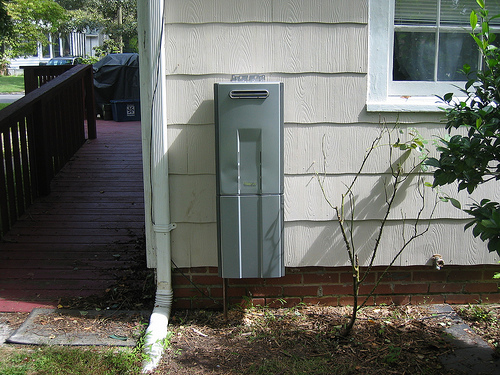Common Problems with Tankless Water Heaters
 On-demand water heaters (also known as tankless water heaters) are more efficient than standard heaters that continually use energy to keep a large tank of water hot. Instead, they quickly heat water as needed when you turn on the hot tap.
On-demand water heaters (also known as tankless water heaters) are more efficient than standard heaters that continually use energy to keep a large tank of water hot. Instead, they quickly heat water as needed when you turn on the hot tap.
However, upgrading to an on-demand water heater is much like replacing an old car. New models are likely more energy-efficient and have plenty of new bells and whistles, but both new cars and new on-demand water heaters also use advanced computer sensors and other electronics. This means they have more visible and audible indicators of potential problems. However, they may also be more complicated to repair and trouble-shoot than older, simpler water heaters -- or cars.
A high-quality tankless water heater should last 20 years, but it must be properly maintained. Hard water (leading to mineral build-up), corrosion, excessive demand, and improper installation can all cause problems with on-demand water heaters. Here are the best ways to address these issues.
Mineral Build-Up
Consumer Reports magazine warns that on-demand water heater maintenance can be expensive. It tested a model that had scaly calcium buildup thanks to mineral-heavy hard water. An indicator light identified the problem. This is a common issue that can decrease efficiency and prematurely damage or break the water heater. Such a breakdown likely won’t be covered by a warranty.
If you have hard water, you will need to use a water softener, install a scale filter, or flush the unit regularly with a vinegar solution, according to the owners’ manual. You may need to hire an HVAC professional to service some models.
Corrosion
On-demand water heaters are less subject to corrosion than tank-type heaters. However, if corrosion does occur, it can lead to serious problems. Condensation may drip onto on the gas burner and cause corrosion that blocks the gas supply. Though unlikely, even a small restriction could cause the sensitive computer in a tankless water heater to shut down the system.
A poorly installed heat exchanger could also be damaged by corrosion. If installed properly, this should not be an issue for the lifespan of the heater. However, in the unlikely event of a corroded heat exchanger, replacement can be very costly.
Demand Overload
If you demand a large amount of hot water at once, such as taking a shower and running the dishwasher at the same time, the heater might not be able to meet the demand. The heater’s computer could simply shut down if it cannot get enough natural gas to heat enough water to meet your demands.
You may need to expand or upgrade your natural gas line to properly install an on-demand water heater. This can add significantly to the installation costs, but could be necessary to ensure the water heater is getting enough gas to function properly.
Combustion Shutdown
On-demand water heaters also must be vented carefully to avoid other computer-generated shutdowns. The heaters have very hot exhaust which must escape quickly and efficiently. If venting is restricted, the computer may shut down the heater. Venting tubes that are too long or convoluted typically cause this type of problem.
Hard water, corrosion, excessive demand and improper installation all cause problems with on-demand water heaters.
Looking for a Pro? Call us (866) 441-6648

Plumbing Average Costs
Plumbers Experiences

Do Your Homework Before You Have A New Water Heater Installed

Gas Line Replacement By A Plumber Who Takes Pride In His Work



